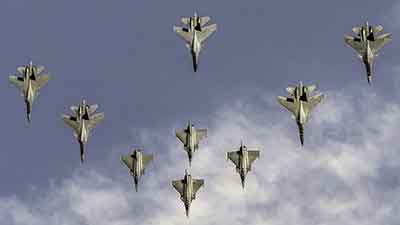Date: 16/02/2023
Relevance: GS-3: Various Security forces and agencies and their mandate.
Key Phrases: New Air Force Doctrine, State-Sponsored Terrorism, Major Changes in Wartime Strategy, Sovereignty Protection, Air Diplomacy, Geopolitical Re-balancing, From Peace to War No War-no Peace Situation, From Airpower to Aerospace Power
Why in News?
- Noting that India’s approach to air power as merely an arm to support joint operations significantly limits its strategic options and narrows its security response matrix, the Indian Air Force (IAF) has come out with a new doctrine that includes lessons from the Russia-Ukraine war and standoff with China.
- The new doctrine has the potential to accommodate major changes in wartime strategy, allowing for the application of future precepts in the use of aerospace power in the Indian security context.
Key Highlights:
- India’s use of air power in all its wars has been limited, except during
the 1971 war due to two aspects:
- The worldwide inadequacy in the comprehension of the inherently complex and rapid technology-driven changes in air power’s characteristics and capabilities.
- India’s traditional surface-dominant security outlook that stems from dealing with a primarily continental threat.
- Both these factors have led to the continued viewing of air power from the isolated lens of support service to the continental and maritime domains, despite the long, consistent, and demonstrated commitment of the Indian Air Force to national security.
Need for New Air Force Doctrine:
- Geopolitical re-balancing, increased assertiveness by emerging powers, regional instabilities, and the expansion of radicalism are but some of the present-day manifestations.
- The perennial friction on the Northern and Western borders; state-sponsored terrorism; left-wing extremism; all underscore the magnitude of external aemphasizings.
- A broad regional scan indicates growing security challenges that impact the political, economic, and security interests in the Indian Ocean Region (IOR) spanning from West Asia to Southeast Asia and the larger Indo Pacific construct.
- Adversaries have adopted grey zone tactics by employing cyber, information, and economic means as instruments of statecraft.
- A continued two-dimensional approach seriously impacts national security along with narrowing India’s strategic outlook, it limits its response options.
- Aerospace power helps shape security operations and external and internal security.
- Sovereignty protection, deterrence, air diplomacy, and nation-building remain peace-time imperatives.
Salient Features of the Indian Airforce Revised Doctrine:
- The doctrine talks about the need for unified war-fighting strategies while laying emphasis on retaining the unique character of air power that can be used as support to the ground and maritime forces.
- The doctrine emphasizes the need to shift from “threat-based and demanded” to “capability-demanded” force requirements.
- The IAF’s revised doctrine underscores the necessity of a more holistic approach towards India’s security and lays out what aerospace can do to bolster it.
- It provides a clearer understanding of the redefined characteristics of aerospace power and its expanded capabilities, not just with respect to contemporary and future warfare and conflicts, but also its place in fostering nation-building, strengthening regional security, and contributing to India’s larger national interests.
- The doctrine provides a clear articulation of the Service objectives evolved out of combat experience, invaluable assessments of international conflicts, and the experience gained in international exercises.
- The strategy covers the entire spectrum of future aerospace applications as it includes the unique no-war-no-peace condition confronting the country apart from peace and war.
Significance of The Doctrine:
- It underpins IAF’s commitment to the larger political objectives of the nation.
- By exploiting its rapid force projection capability, enormous soft power, and international outreach in assisting statecraft and diplomacy, the document underscores the IAF’s inevitable and increasing role in the strategy for security and growth for all in the region (SAGAR), as well as in the larger Indo-Pacific construct.
- Though the domain of future aerospace power lies primarily with the IAF, the doctrine acknowledges that other services civil aviation, and space agencies also contribute to this strength.
- Despite the air and space continuum, IAF’s multitude of space-based dependencies and applications, and the future necessity of aerospace defence of India’s space assets and ground-based infrastructure, the document refrains from asserting ownership of the arena.
- It maturely acknowledges that future aerospace and defence capabilities, related R&D, and associated civil-military industrial capabilities are national force multipliers.
Conclusion:
- Since national security is every citizen’s concern and given the efforts underway to evolve national defense and security strategies, the doctrine credibly conveys what aerospace power has, can, and will do for the nation, and the need for greater awareness of it.
Source: Indian Express
Mains Question:
Q. Highlight the salient features of new draft air force doctrine. How does it help in dealing with various internal as well as external threats faced by India.(250 words).






















